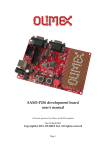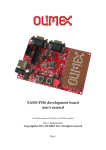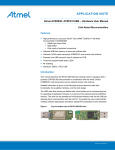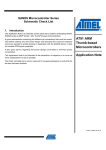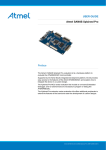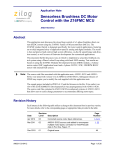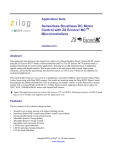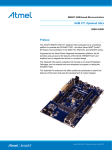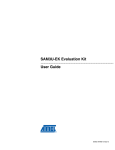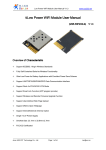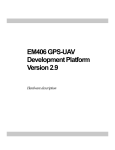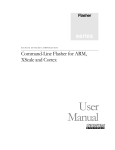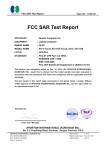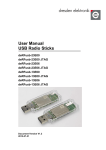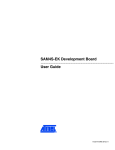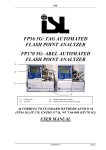Download SAM3-H256 User Manual
Transcript
SAM3-H256 development board Users Manual All boards produced by Olimex are ROHS compliant Rev. Initial, April 2011 Copyright(c) 2011, OLIMEX Ltd, All rights reserved Page 1 INTRODUCTION: Atmel’s ATSAM3S4BA-AU is a member of a series of Flash microcontrollers based on the high performance 32-bit ARM Cortex-M3 RISC processor. It operates at a maximum speed of 64 MHz and features a 256 Kbyte Flash and a 48 Kbyte SRAM, Full Speed USB Device port with embedded transceiver, an External Bus Interface featuring a Static Memory Controller providing connection to SRAM, PSRAM, NOR Flash and NAND Flash, 2x USARTs, 2x UARTs, 2x TWIs, 3x SPI, an I2S, as well as 1 PWM timer, 6x general-purpose 16-bit timers, an RTC, an ADC, a 12-bit DAC and an analog comparator. SAM3-H256 has connectors for JTAG and USB, extension headers for all microcontroller's ports, reset button, power and status leds. BOARD FEATURES: • Microcontroller: ATSAM3S4BA-AU. • standard JTAG connector with ARM 2x10 pin layout for programming/debugging with ARM-JTAG • status LED • on board voltage regulator 3.3V with up to 800mA current • power supply LED • power supply filtering capacitor • RESET circuit • RESET button • 12.000 Mhz crystal on socket • extension headers for all microcontroller's ports • PCB: FR-4, 1.5 mm (0,062"), soldermask, silkscreen component print • Dimensions: 50.00 x 33.75 mm (1.97 x 1.33") ELECTROSTATIC WARNING: The SAM3-H256 board is shipped in protective anti-static packaging. The board must not be subject to high electrostatic potentials. General practice for working with static sensitive devices should be applied when working with this board. BOARD USE REQUIREMENTS: Cables: The cable you will need depends on the programmer/debugger you use. If you use ARM-JTAG-EW, you will need USB A-B cable. Hardware: Programmer/Debugger ARM-JTAG-EW or other compatible programming/debugging tool if you work with EW-ARM. Page 2 You can use also ARM-USB-OCD, ARM-USB-TINY, ARM-USB-OCD-H, ARMUSB-TINY-H. PROCESSOR FEATURES: SAM3-H256 board use ARM-based microcontroller ATSAM3S4BA-AU from Atmel Corporation with these features: − Core − ARM® Cortex®-M3 revision 2.0 running at 64 MHz − Memory Protection Unit (MPU) − Thumb®-2 instruction set − Pin-to-pin compatible with AT91SAM7S legacy products (48- and 64-pin versions) − Memories − − − 256 Kbytes embedded Flash, 128-bit wide access, memory accelerator, single plane − 48 Kbytes embedded SRAM − 16 Kbytes ROM with embedded bootloader routines (UART, USB) and IAP routines − 8-bit Static Memory Controller (SMC): SRAM, PSRAM, NOR and NAND Flash support − Memory Protection Unit (MPU) System − Embedded voltage regulator for single supply operation − Power-on-Reset (POR), Brown-out Detector (BOD) and Watchdog for safe operation − Quartz or ceramic resonator oscillators: 3 to 20 MHz main power with Failure Detection and optional low power 32.768 kHz for RTC or device clock − High precision 8/12 MHz factory trimmed internal RC oscillator with 4 MHz default frequency for device startup. In-application trimming access for frequency adjustment − Slow Clock Internal RC oscillator as permanent low-power mode device clock − Two PLLs up to 130 MHz for device clock and for USB − Temperature Sensor − Up to 22 peripheral DMA (PDC) channels Low Power Modes − Sleep and Backup modes, down to 3 μA in Backup mode Page 3 − − − Ultra low power RTC Peripherals − USB 2.0 Device: 12 Mbps, 2668 byte FIFO, up to 8 bidirectional Endpoints. On-Chip Transceiver − 2 USARTs with ISO7816, IrDA®, RS-485, SPI, Manchester and Modem Mode − Two 2-wire UARTs − 2 Two Wire Interface (I2C compatible), 1 SPI, 1 Serial Synchronous Controller (I2S), 1 High Speed Multimedia Card Interface (SDIO/SD Card/MMC) − 3 Three-Channel 16-bit Timer/Counter with capture, waveform, compare and PWM mode. Quadrature Decoder Logic and 2-bit Gray Up/Down Counter for Stepper Motor − 4-channel 16-bit PWM with Complementary Output, Fault Input, 12bit Dead Time Generator Counter for Motor Control − 32-bit Real-time Timer and RTC with calendar and alarm features − 10-channel ADC with differential input mode and programmable gain stage − Two 12-bit DAC outputs − One Analog Comparator with flexible input selection, Selectable input hysteresis − 32-bit Cyclic Redundancy Check Calculation Unit (CRCCU) − 47 I/O lines with external interrupt capability (edge or level sensitivity), debouncing, glitch filtering and on-die Series Resistor Termination − Three 32-bit Parallel Input/Output Controllers, Peripheral DMA assisted Parallel Capture Mode I/O Page 4 BLOCK DIAGRAM: Page 5 MEMORY MAP: Page 6 1N5819S/SMD Page 7 USB USB_B G ND C13 10n NA(IRLML6402) FET1 S H IE L D 1 2 3 4 33p C8 R15 NA(1.5K) R14 27R R17 27R 15p C14 PUP R16 NA(100) 0 R11 R18 330K 0 R10 15p C15 R7 47K RST R8 47K OUT R19 330K TDO TDI TMS TCK R9 47K R3 390/1% R1 240/1% 2 VCC C17 2.2uF 1n C11 100n 100n C18 3.3V 100n C19 RESET C9 100n R12 10K RST VIN 3.3V 3.3V R2 560 PWR C16 C12 100n C10 100n C7 2.2uF C5 100n GND RESET 1 U1 MCP130T 47uF/6.3V C1 3 USB 100n NA(47K) R13 R6 47K R5 47K 10uF/16V C2 IN ADJ/GND 3.3V + C3 D1 3.3V JTAG 1 3 TRST 5 7 9 11 RTCK 13 15 17 19 3.3V + 2 4 6 8 10 12 14 16 18 20 VIN VR1(3.3V) LM1117IMPX-ADJ 100n C20 C6 10p C4 10p TEST 1x2 RST 100n C21 Q1 12MHz/PTH TCK TDI TDO TMS 2 1 3.3V EXT2-17 EXT2-18 EXT2-19 EXT2-20 L_E 1x2 2 1 STAT 8 PB13 PB14 PB12 R4 560 3.3V 2 17 46 60 12 24 54 64 8 18 45 58 59 7 61 62 63 56 57 50 53 33 49 51 40 39 55 ATSAM3S4BA-AU PA0/PWMH0/TIOA0/A17/WKUP0 PA1/PWMH1/TIOB0/A18/WKUP1 PA2/PWMH2/SCK0/DATRG/WKUP2 PA3/TWD0/NPCS3 JTAGSEL PA4/TWCK0/TCLK0/WKUP3 PB7/TCK/SWCLK PA5/RXD0/NPCS3/WKUP4 PB4/TWD1/PWMH2/TDI PA6/TXD0/PCK0 PB5/TWCK1/PWML0/WKUP13/TDO/TRACESWO PA7/RTS0/PWMH3/XIN32 PB6/TMS/SWDIO PA8/CTS0/ADTRG/WKUP5/XOUT32 PA9/URXD0/NPCS1/PWMFI0/WKUP6 PB10/DDM PA10/UTXD0/NPCS2 PB11/DDP PA11/NPCS0/PWMH0/WKUP7 PA12/MISO/PWMH1 PB14/NPCS1/PWMH3/DAC1 PA13/MOSI/PWMH2 PA14/SPCK/PWMH3/WKUP8 PB9/XIN PA15/TF/TIOA1/PWML3/WKUP14/PIODCEN1 PA16/TK/TIOB1/PWML2/WKUP15/PIODCEN2 PB8/XOUT PA17/TD/PCK1/PWMH3/AD0 PA18/RD/PCK2/A14/AD1 VDDIN PA19/RK/PWML0/A15/AD2/WKUP9 PA20/RF/PWML1/A16/AD3/WKUP10 PB13/PWML2/PCK0/DAC0 PA21/RXD1/PCK1/AD8 PA22/TXD1/NPCS3/NCS2/AD9 VDDIO1 PA23/SCK1/PWMH0/A19/PIODCCLK VDDIO2 PA24/RTS1/PWMH1/A20/PIODC0 VDDIO3 PA25/CTS1/PWMH2/A23/PIODC1 PA26/DCD1/TIOA2/MCDA2/PIODC2 VDDOUT PA27/DTR1/TIOB2/MCDA3/PIODC3 PA28/DSR1/TCLK1/MCCDA/PIODC4 VDDPLL PA29/RI1/TCLK2/MCCK/PIODC5 PA30/PWML2/NPCS2/MCDA0/WKUP11/PIODC6 VDDCORE1 PA31/NPCS1/PCK2/MCDA1/PIODC7 VDDCORE2 VDDCORE3 ADVREF GND1 PB0/PWMH0/AD4 GND2 PB1/PWMH1/AD5 GND3 PB2/URXD1/NPCS2/WKUP12/AD6 GND4 PB3/UTXD1/PCK2/AD7 TST NRST PB12/PWML1/ERASE U2 http://www.olimex.com/dev CO PYRIGHT(C) 2011, O LIMEX Ltd. Rev. Initial SAM3-H256 1 3 4 5 6 48 47 44 43 36 35 34 32 31 30 29 28 27 22 21 20 19 9 10 13 16 11 14 15 23 25 26 37 38 41 42 52 PUP AR A4 A5 A6 A7 17 18 19 20 21 22 23 24 25 26 27 28 29 30 31 8 9 10 11 12 13 14 15 0 1 2 3 4 5 6 7 EXT2-13 EXT2-14 EXT2-15 EXT2-16 PB3 EXT1-1 EXT1-2 EXT1-3 EXT1-4 EXT1-5 EXT1-6 EXT1-7 EXT1-8 EXT1-9 EXT1-10 EXT1-11 EXT1-12 EXT1-13 EXT1-14 EXT1-15 EXT1-16 EXT1-17 EXT1-18 EXT1-19 EXT1-20 EXT2-1 EXT2-2 EXT2-3 EXT2-4 EXT2-5 EXT2-6 EXT2-7 EXT2-8 EXT2-9 EXT2-10 EXT2-11 EXT2-12 SCHEMATIC: BOARD LAYOUT: Page 8 POWER SUPPLY CIRCUIT: SAM3-H256 is typically power supplied with +5 V from USB, but it also can be power supplied with +5VDC via extension connector (signal VIN from EXT2 connector pin17). The programmed board power consumption is about 50 mA. RESET CIRCUIT: SAM3-H256 reset circuit includes U1 (MCP130T), R12 (10k), JTAG connector pin 15, EXT2 pin 20, ATSAM3S4BA-AU pin 39 (NRST) and RESET button. CLOCK CIRCUIT: Quartz crystal Q1 12.000 MHz is connected to ATSAM3S4BA-AU pin 61 (PB8/XOUT) and pin 62 (PB9/XIN). JUMPER DESCRIPTION: L_E This jumper, when closed, enables status led – STAT. Default state is closed. TEST This jumper, when closed, connects ATSAM3S4BA-AU pin 40 (TST) to 3.3V. The TST pin is used for JTAG Boundary Scan Manufacturing Test or Fast Flash programming mode. When TEST jumper is opened – normal mode is enabled. Default state is opened. Page 9 Description for programming via USB port using SAM-BA software The ATSAM3S4BA-AU can be programmed via USB using the SAM-BATM software. Before being able to use SAM-BA, a recovery procedure, which consists of copying the SAM-BA Boot Assistant into Flash must be performed as follows: 1. Disconnect board from USB 2. Connect PB12 to 3.3V 3. Power up the board 4. Wait 10s 5. Power down the board 6. Remove the connection between PB12 and 3.3V 7. Power up the board via USB 8. If SAM-BA USB driver are installed you can use SAM-BA tool INPUT/OUTPUT: Status Led (green) with name STAT connected via jumper L_E to ATSAM3S4BAAU pin 31 (PA8/CTS0/ADTRG/WKUP5/XOUT32). Power-on LED (red) with name PWR – this LED shows that +3.3V is applied to the board. Reset button with name RESET connected to ATSAM3S4BA-AU pin 39 (NRST). Page 10 EXTERNAL CONNECTORS DESCRIPTION: JTAG: The JTAG connector allows the software debugger to talk via a JTAG (Joint Test Action Group) port directly to the core. Instructions may be inserted and executed by the core thus allowing ATSAM3S4BA-AU memory to be programmed with code and executed step by step by the host software. For more details refer to IEEE Standard 1149.1 - 1990 Standard Test Access Port and Boundary Scan Architecture and ATSAM3S4BA-AU datasheets and users manual. Pin # Signal Name Pin # Signal Name 1 3.3V 2 3.3V 3 TRST 4 GND 5 TDI 6 GND 7 TMS 8 GND 9 TCK 10 GND 11 RTCK 12 GND 13 TDO 14 GND 15 RST 16 GND 17 NC 18 GND 19 NC 20 GND Page 11 USB: Pin # Signal Name 1 VIN 2 DDM 3 DDP 4 GND EXT1: Pin # Signal Name Pin # Signal Name 1 0 - (PA0) 2 1 - (PA1) 3 2 – (PA2) 4 3 – (PA3) 5 4 – (PA4) 6 5 – (PA5) 7 6 – (PA6) 8 7 – (PA7) 9 8 - (PA8) 10 9 – (PA9) 11 10 – (PA10) 12 11 – (PA11) 13 12 – (PA12) 14 13 – (PA13) 15 14 – (PA14) 16 15 – (PA15) 17 PUP – (PA16) 18 17 – (PA17) 19 18 – (PA18) 20 19 – (PA19) Page 12 EXT2: Pin # Signal Name Pin # Signal Name 1 20 – (PA20) 2 21 – (PA21) 3 22 – (PA22) 4 23 – (PA23) 5 24 – (PA24) 6 25 – (PA25) 7 26 – (PA26) 8 27 – (PA27) 9 28 – (PA28) 10 29 – (PA29) 11 30 – (PA30) 12 31 – (PA31) 13 AR – (ADVREF) 14 A4 – (PB0) 15 A5 – (PB1) 16 A6 - (PB2) 17 VIN 18 VCC 19 GND 20 RST Page 13 MECHANICAL DIMENSIONS: Page 14 AVAILABLE DEMO SOFTWARE: Demonstrates USB mouse and a blinking led. You can find it at http://www.olimex.com/dev at the board's specific page. Page 15 ORDER CODE: SAM3-H256 - assembled and tested board How to order? You can order to us directly or by any of our distributors. Check our web www.olimex.com/dev for more info. Revision history: Board's Revision: Initial, October 2010 Manual's Revision Initial, April 2011 Page 16 Disclaimer: © 2011 Olimex Ltd. All rights reserved. Olimex®, logo and combinations thereof, are registered trademarks of Olimex Ltd. Other terms and product names may be trademarks of others. The information in this document is provided in connection with Olimex products. No license, express or implied or otherwise, to any intellectual property right is granted by this document or in connection with the sale of Olimex products. Neither the whole nor any part of the information contained in or the product described in this document may be adapted or reproduced in any material from except with the prior written permission of the copyright holder. The product described in this document is subject to continuous development and improvements. All particulars of the product and its use contained in this document are given by OLIMEX in good faith. However all warranties implied or expressed including but not limited to implied warranties of merchantability or fitness for purpose are excluded. This document is intended only to assist the reader in the use of the product. OLIMEX Ltd. shall not be liable for any loss or damage arising from the use of any information in this document or any error or omission in such information or any incorrect use of the product. Page 17

















